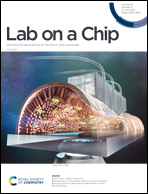Room-temperature bonding of glass chips via PTFE-assisted plasma modification for nanofluidic applications†
Abstract
Fused-silica glass, as a desirable material with rigidity, biological inertness, and favorable light transmission for nanofluidic devices, should be assembled via low-temperature bonding technology to hermetically seal channels for stable liquid manipulation in extended-nano (101–103 nm) space. Confronted with the predicament of localized functionalization of nanofluidic applications (e.g. DNA microarray) with temperature-sensitive structures, the room-temperature direct bonding of glass chips to achieve modification of channels prior to bonding offers a considerably attractive solution to avoid component denaturation during the conventional post-bonding heating process. Therefore, we developed a nano-structure friendly and technically convenient room-temperature (RT, 25 °C) glass–glass direct bonding technology using polytetrafluoroethylene (PTFE)-assisted plasma modification without a requirement for special equipment. Unlike the establishment of chemical functionalities relying on immersion in potent but dangerous chemicals like HF, the fluorine radicals (F*) from PTFE pieces with superior chemical inertness were introduced on glass surfaces via O2 plasma sputtering and constructed fluorinated silicon oxides on the glass surfaces effectively, eliminating the significant etching effect of HF to protect fine nanostructures. Very strong bonding was obtained at RT with no heating and the high-pressure resistant glass–glass interfaces were evaluated under high-pressure-driven flow conditions up to 2 MPa based on a two-channel liquid introduction system. Moreover, the favorable optical transmittance of the fluorinated bonding interface demonstrated a capacity for high-resolution optical detection or liquid sensing.

- This article is part of the themed collection: Andreas Manz – Pioneer, Mentor, Friend


 Please wait while we load your content...
Please wait while we load your content...